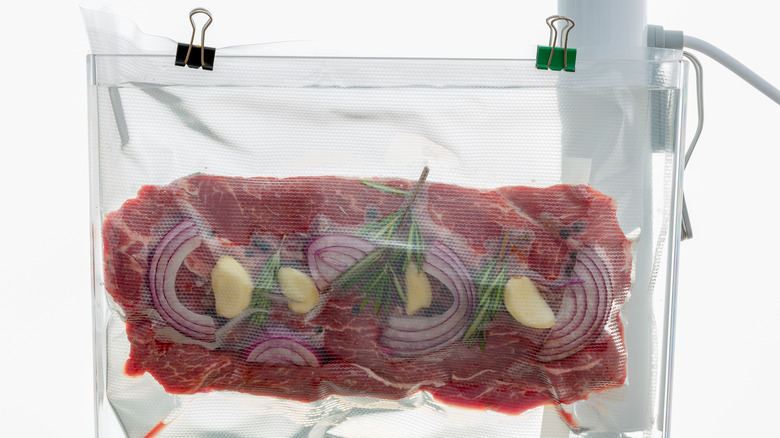Why Air Pockets In Sous Vide Aren't Necessarily A Reason To Panic
If you're bothering to spend the effort warming up a water bath, packing your food up in bags, and spending a few hours waiting for your delectable creation to cook to perfection, we know you want to get all the steps right. Sous vide is a great hands-off way to prepare juicy meats and perfectly softened vegetables, but the method has some mandatory steps for success.
One of those is to carefully seal the food you're cooking before placing it in a bath, typically in a food-grade plastic bag. Sometimes, no matter how carefully you handle the bag, you'll find pockets of air in the bag after you've started cooking. Although the air isn't optimal, it's no cause for alarm, and there are various ways to manage those air bubbles.
The air pockets can cause a couple of problems — the most annoying is that the bag will float to the top of your water bath, making even heating more difficult. Another problem is that a large air pocket can cause the food in your bag to take longer to heat. That's because air doesn't transfer heat as well as water does, and the air keeps heat away from the food it's in contact with. Both of these problems have easy solutions: Weigh the bag down so it doesn't float, and allow for a little more cooking time.
Why air pockets form, and the steps to overcome them
Air pockets in sous vide bags occur when either the bag has been improperly sealed or the uneven distribution of ingredients causes a void. Roughly cut or whole vegetables with irregular shapes or meats with stiff corners (from bone or fat) can trap air within the bag. Consider this during prep, but also, as you seal the bag, it's helpful to press ingredients lightly to release any air trapped inside. And don't hesitate to open and reseal a bag with large air pockets.
If you notice pockets while the bags are cooking despite your best sealing efforts, there are a few things you can do to mitigate this. You can pause the cooking process and carefully adjust the placement of the bags. Gently squeeze the air out if you've used a zip-top bag that can be opened easily or reposition the ingredients, adding weights to the bag if necessary to be sure the food is fully submerged underwater.
A trick to prevent air bubbles in sous vide bags is to clamp them to the side of your sous vide container with the tops open above the water line. Air that forms during cooking will just rise up and out of the bag. If, however, air pockets cannot easily be eliminated, simply adjust the time to compensate for uneven cooking.

